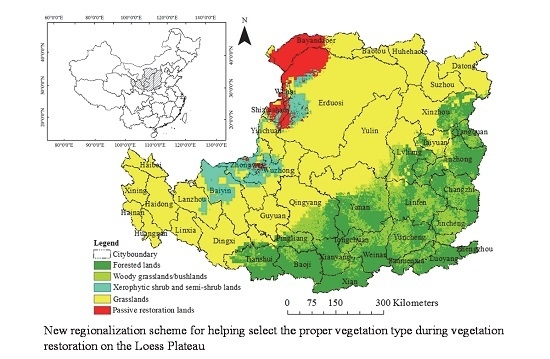A New Regionalization Scheme for Effective Ecological Restoration on the Loess Plateau in China
Abstract
:1. Introduction
2. Materials and Methods
2.1. Study Area
2.2. Data Acquisition
2.2.1. Soil Data
2.2.2. Meteorological Data
2.2.3. Land Cover Data
2.2.4. Vegetation Index Data
2.2.5. Estimation of Net Primary Productivity
2.2.6. Aspect Data
2.3. Data Analyses
2.3.1. Design of the Vegetation Restoration Regionalization Scheme
2.3.2. Assessment of the Regionalization Scheme
3. Results
3.1. General Vegetation Conditions on the Loess Plateau
3.2. Vegetation Conditions in the Defined N and R Regions
3.3. A New Regionalized Vegetation Restoration Scheme
3.3.1. Regions Suitable for Tree Restoration
3.3.2. Regions Suitable for Woody Grass/Bush Restoration
3.3.3. Regions Suitable for Grass Restoration
3.3.4. Regions Suitable for Xerophytic Shrub/Semi-Shrub Restoration
3.3.5. Regions Suitable Only for Passive Restoration without Irrigation
3.4. Assessment of the New Regionalized Vegetation Restoration Scheme
3.4.1. Evaluation Using the Independent Dataset
3.4.2. Comparison of the New Regionalization Scheme with the Chinese Eco-Geographical Regionalization Scheme
4. Discussion
4.1. Potential applications of the scheme to vegetation restoration on the Loess Plateau
4.2. Potential Applications of the Proposed Method to Other Regions
5. Conclusions
Acknowledgments
Author Contributions
Conflicts of Interest
References
- Shi, H.; Shao, M. Soil and water loss from the Loess Plateau in China. J. Arid Environ. 2000, 45, 9–20. [Google Scholar] [CrossRef]
- Zhou, D.; Zhao, S.; Liu, S.; Zhang, L. Modeling the effects of the sloping land conversion program on terrestrial ecosystem carbon dynamics in the Loess Plateau: A case study with Ansai County, Shanxi province, China. Ecol. Model. 2014, 200, 47–54. [Google Scholar] [CrossRef]
- Xie, B.; Qin, Z.; Wang, Y.; Chang, Q. Spatial and temporal variation in terrestrial net primary productivity on Chinese Loess Plateau and its influential factors. Trans. Chin. Soc. Agric. Eng. 2014, 30, 244–253. [Google Scholar]
- Feng, X.; Fu, B.; Lu, N.; Zeng, Y.; Wu, B. How ecological restoration alters ecosystem services: An analysis of carbon sequestration in China’s Loess Plateau. Sci. Rep. 2013, 3, 2846. [Google Scholar] [CrossRef] [PubMed]
- Chen, Y.; Wang, K.; Lin, Y.; Shi, W.; Song, Y.; He, X. Balancing green and grain trade. Nat. Geosci. 2015, 8, 739–741. [Google Scholar] [CrossRef]
- Song, X.Z.; Peng, C.H.; Zhou, G.M.; Jiang, H.; Wang, W.F. Chinese grain for green program led to highly increased soil organic carbon levels: A meta-analysis. Sci. Rep. 2014, 4, 4460. [Google Scholar] [CrossRef] [PubMed]
- Lü, Y.; Fu, B.; Feng, X.; Zeng, Y.; Liu, Y.; Chang, R.; Sun, G.; Wu, B. A policy-driven large scale ecological restoration: Quantifying ecosystem services changes in the Loess Plateau of China. PLoS ONE 2012, 7, e31782. [Google Scholar] [CrossRef] [PubMed]
- Wang, L.; Shao, M. Soil desiccation under returning farm to forests on the Loess Plateau. World Forest Res. 2004, 17, 57–60. [Google Scholar] [CrossRef]
- Zhang, Y.; Huang, M.; Lian, J. Spatial distributions of optimal plant coverage for the dominant tree and shrub species along a precipitation gradient on the central. Agric. Forest Meteorol. 2015, 206, 69–84. [Google Scholar] [CrossRef]
- Sayer, J.; Chokkalingam, U.; Poulsen, J. The restoration of forest biodiversity and ecological values. Forest Ecol. Manag. 2004, 201, 3–11. [Google Scholar] [CrossRef]
- Gelviz-Gelvez, S.M.; Pavón, N.P.; IIoldi-Rangel, P.; Ballesteros-Barrera, C. Ecological niche modeling under climate change to select shrubs for ecological restoration in central Mexico. Ecol. Eng. 2015, 74, 302–309. [Google Scholar] [CrossRef]
- Kang, M.; Dong, S.; Huang, X.; Xiong, M.; Chen, H.; Zhang, X. Ecological regionalization of suitable trees, shrubs and herbages for vegetation restoration in forming-pastoral zone of northern China. Acta Bot. Sin. 2003, 45, 1157–1165. [Google Scholar]
- Liu, H.; Wang, L.; Yang, J.; Nakagoshi, N.; Liang, C.; Wang, W.; Lv, Y. Predictive modeling of the potential natural vegetation pattern in northeast China. Ecol. Res. 2009, 24, 1313–1321. [Google Scholar] [CrossRef]
- Rondeaux, G.; Steven, M.; Baret, F. Optimization of soil-adjusted vegetation indices. Remote Sens. Environ. 1996, 55, 95–107. [Google Scholar] [CrossRef]
- Wu, C.; Niu, Z.; Tang, Q.; Huang, W. Estimating chlorophyll content from hyperspectral vegetation indices: Modeling and validation. Agric. Forest Meteorol. 2008, 148, 1230–1241. [Google Scholar] [CrossRef]
- Kokaly, R.F.; Asner, G.P.; Ollinger, S.V.; Martin, M.E.; Wessman, C.A. Characterizing canopy biochemistry from imaging spectroscopy and its application to ecosystem studies. Remote Sens. Environ. 2009, 113 (Suppl. 1), S78–S91. [Google Scholar] [CrossRef]
- Liang, W.; Yang, Y.; Fan, D.; Guan, H.; Zhang, T.; Long, D.; Zhou, Y.; Bai, D. Analysis of spatial and temporal patterns of net primary production and their climate controls in China from 1982 to 2010. Agric. Forest Meteorol. 2015, 204, 22–36. [Google Scholar] [CrossRef]
- Chen, Y.; Yang, K.; He, J.; Qin, J.; Shi, J.; Du, J. Improving land surface temperature modeling for dry land of China. J. Geophys. Res. 2011, 116, D20104. [Google Scholar] [CrossRef]
- Hanse, M.R.; Defries, J.R.; Townshend, G.; Sohlberg, R. UMD Global Land Cover Classification, 1 Kilometer, 1.0; University of Maryland: College Park, MD, USA, 1981–1994.
- Tian, H.; Cao, C.; Chen, W.; Bao, S.; Yang, B.; Myneni, R.B. Response of vegetation activity dynamic to climatic change and ecological restoration programs in Inner Mongolia from 2000 to 2012. Ecol. Eng. 2015, 82, 276–289. [Google Scholar] [CrossRef]
- Moreno, A.; Neumann, M.; Hasenauer, H. Optimal resolution for linking remotely sensed and forest inventory data in Europe. Remote Sens. Environ. 2016, 183, 109–119. [Google Scholar] [CrossRef]
- Potter, C.S.; Randerson, J.T.; Field, C.B.; Matson, P.A.; Vitousek, P.M.; Mooney, H.A.; Klooster, S.A. Terretrial ecosystem production: A process model based on global satellite and surface data. Glob. Biogeochem. Cycles 1993, 7, 811–841. [Google Scholar] [CrossRef]
- Crabtree, R.; Potter, C.; Mullen, R.; Sheldon, J.; Huang, S.; Harmsen, J.; Rodaman, A.; Jean, C. A modeling and spatio-temporal analysis framework for monitoring environmental change using NPP as an ecosystem indicator. Remote Sens. Environ. 2009, 113, 1486–1496. [Google Scholar] [CrossRef]
- Xu, X.; Tan, Y.; Yang, G.; Li, H.; Su, W. Impacts of China’s Three Gorges Dam project on net primary productivity in the reservoir area. Sci. Total Environ. 2011, 409, 4656–4662. [Google Scholar] [CrossRef] [PubMed]
- Liu, C.; Dong, X.; Liu, Y. Changes of NPP and their relationship to climate factors based on the transformation of different scales in Gansu, China. Catena 2015, 125, 190–199. [Google Scholar] [CrossRef]
- Potter, C.; Gross, P.; Genovese, V.; Smith, M.-L. Net primary productivity of forest stands in New Hampshire estimated from Landsat and MODIS satellite data. Carbon Balanc. Manag. 2007, 2, 9. [Google Scholar] [CrossRef] [PubMed]
- Flury, B.K.; Riedwyl, H. Standard distance in univariate and multivariate analysis. Am. Stat. 1986, 40, 249–251. [Google Scholar]
- Wang, J.C.; Hu, J.; Huang, X.X.; Xu, S.C. Assessment of different genetic distances in constructing cotton core suset by genotypic value. J. Zhejiang Univ. Sci. B 2008, 9, 356–362. [Google Scholar] [CrossRef] [PubMed]
- Chen, P.; Wang, J.; Huang, W.; Tremblay, N.; Ou, Y.; Zhang, Q. Critical nitrogen curve and remote detection of nitrogen nutrition index for corn in the northwestern plain of Shandong province, China. IEEE J.-STARS 2013, 6, 682–689. [Google Scholar] [CrossRef]
- Zheng, D. Chinese Ecological Geographic Area System Research; The Commercial Press: Beijing, China, 2008. [Google Scholar]
- Zhang, T.; Peng, J.; Liu, Y.; Zhao, M. Eco-geographical regionalization in Loess Plateau based on the dynamic consistency of vegetation. Geogr. Res. 2015, 34, 1643–1661. [Google Scholar]
- Chen, C.; Wu, J. The degradation and restoration of environment in mining city in Loess Plateau. Res. Soil Water Conserv. 2007, 14, 129–132. [Google Scholar]
- Gao, Q.; Liu, T. Causes and consequences of shrub encroachment in arid and semiarid region: A disputable issue. Arid Land Geogr. 2015, 38, 1202–1212. [Google Scholar]
- Yang, L.; Wei, W.; Mo, B.; Chen, L. Soilwater deficit under different artificial vegetation restoration in the semi-arid hilly region of the Loess Plateau. Acta Ecol. Sin. 2011, 31, 3060–3068. [Google Scholar]
- Du, Q.; Li, M.; Bian, Z.; Zhang, K. Dynamic Change of Vegetation under different land use patterns: A case study in Yanchi County, Ningxia. Arid Zone Res. 2016, 33, 569–576. [Google Scholar]
- Dai, Y.; Hou, X.; Yan, Z.; Wu, H.; Xie, J.; Zhang, X.; Gao, L. Soil microbes and the chemical properties of the rhizosphere and non-rhizosphere soil under two types of vegetation restoration in the Hobq Sandy Land of Inner Mongolia, China. Acta Ecol. Sin. 2016, 36, 6353–6364. [Google Scholar]
- Li, Y.; Shao, M.; Chen, H.; Hou, Z.; Zheng, J. Impacts of vegetation recovery on soil physical properties in the cross area of wind-water erosion. Acta Ecol. Sin. 2010, 30, 4306–4316. [Google Scholar]
- Wen, X.; Yang, X.; Liu, Y.; Liu, X. Trends and factors influencing vegetation seasonal dynamics in Changwu County on the Loess Plateau. Resour. Sci. 2016, 38, 768–776. [Google Scholar]
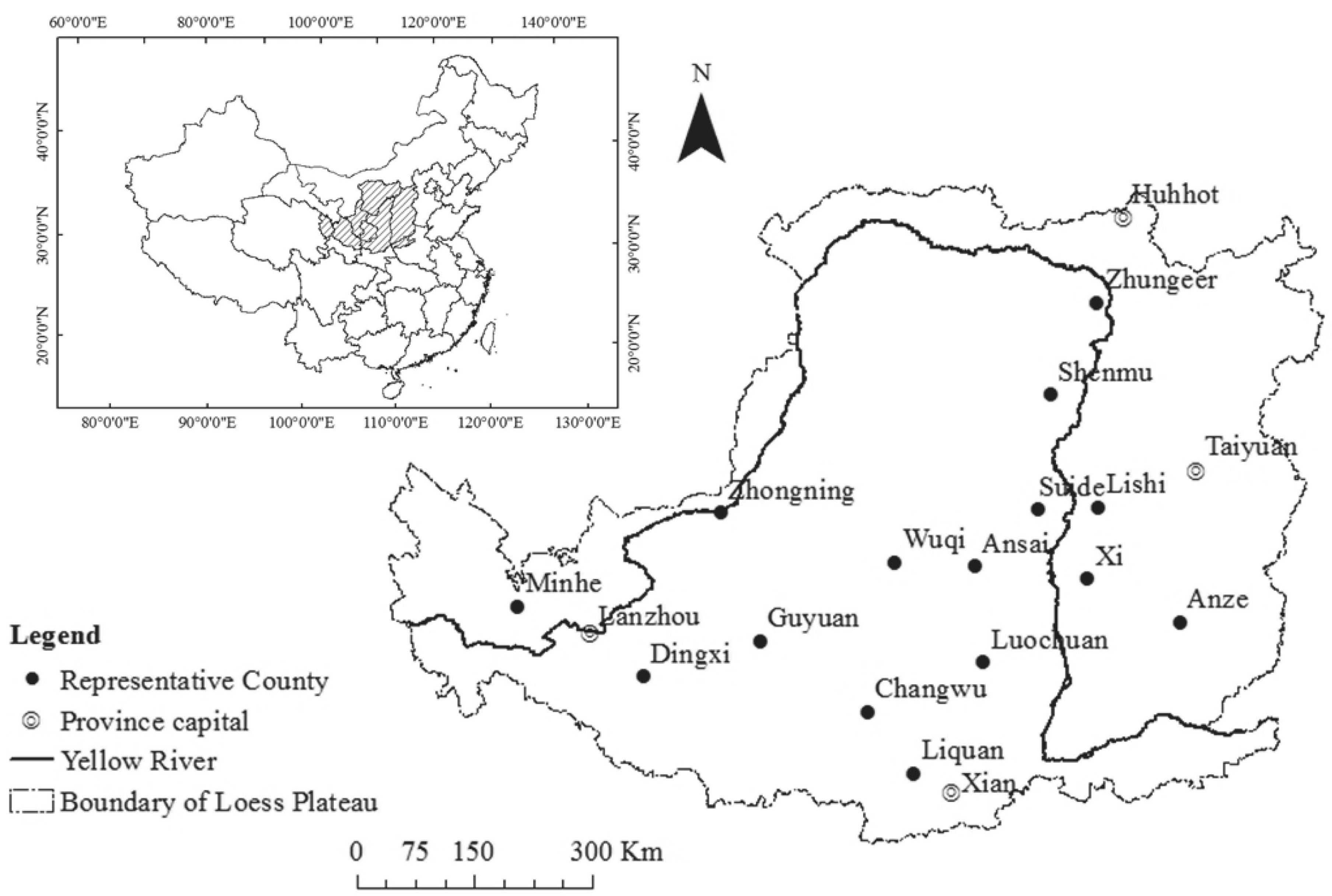
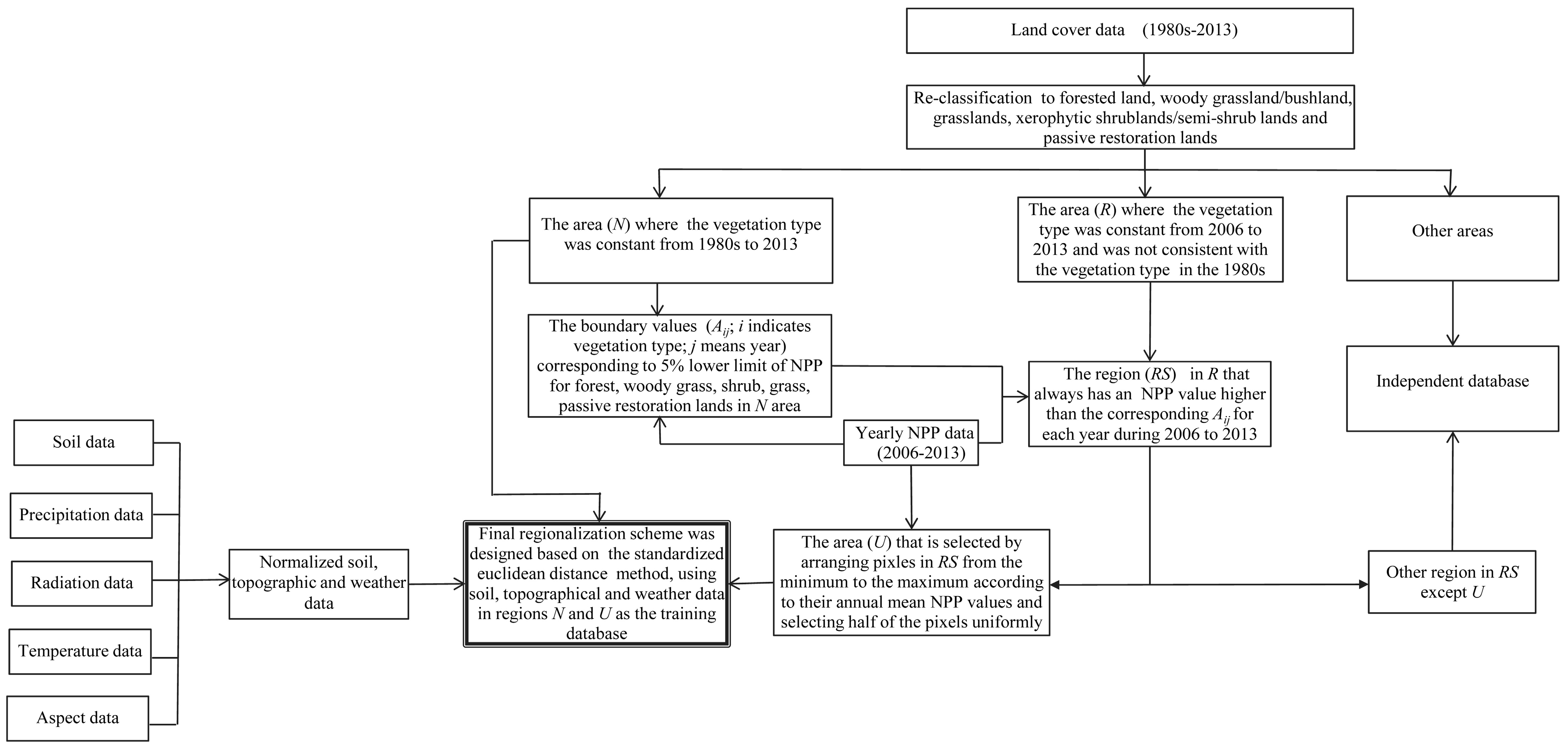
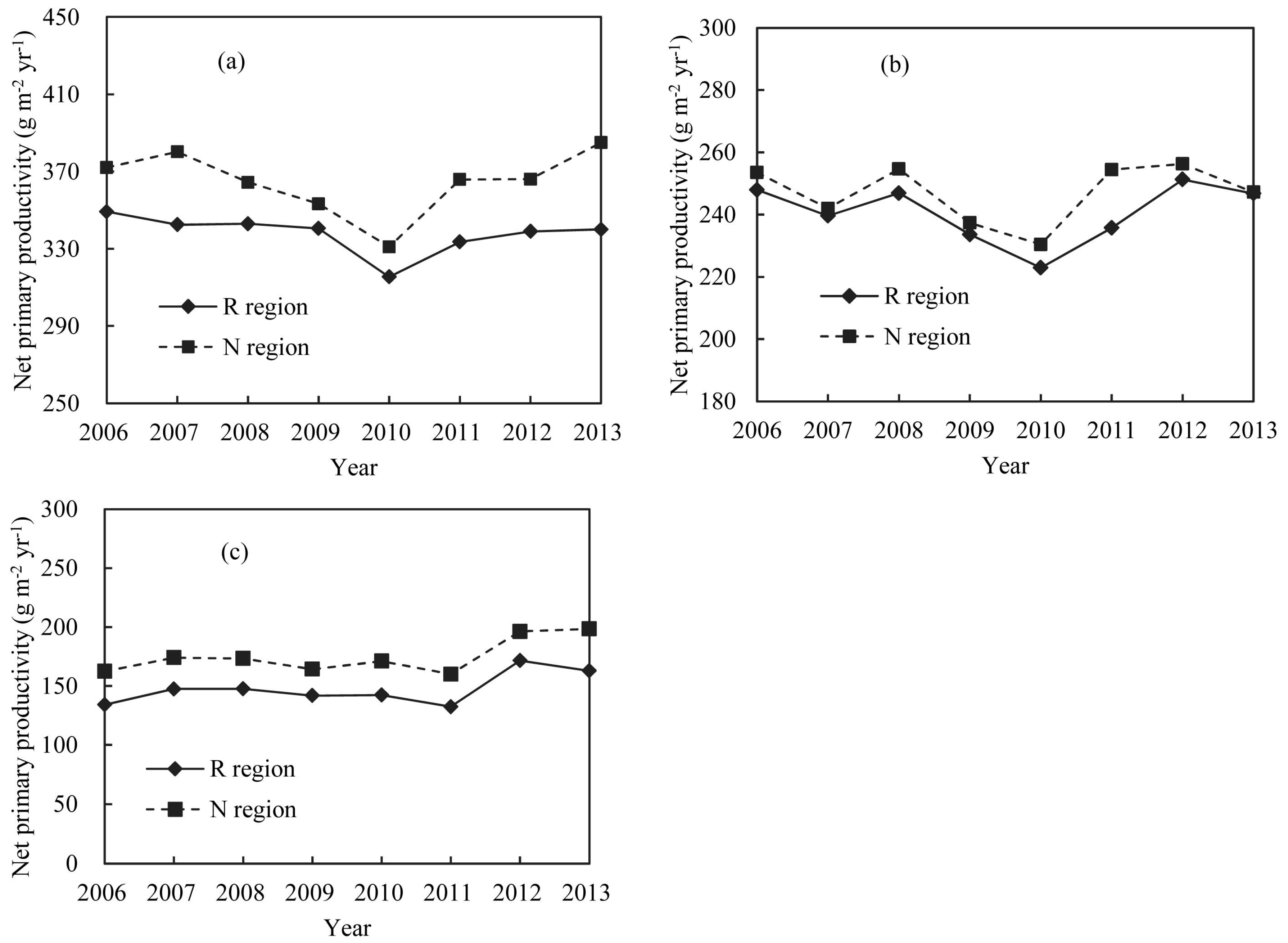
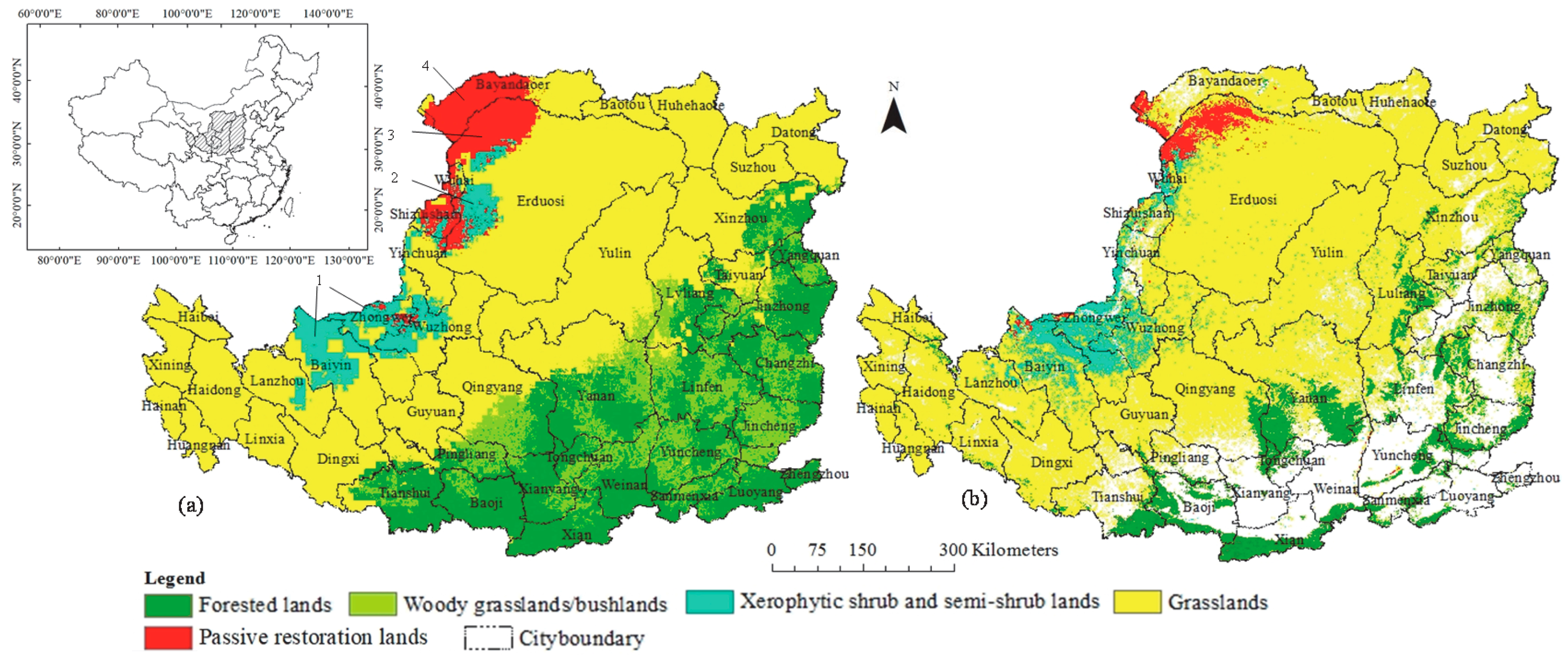
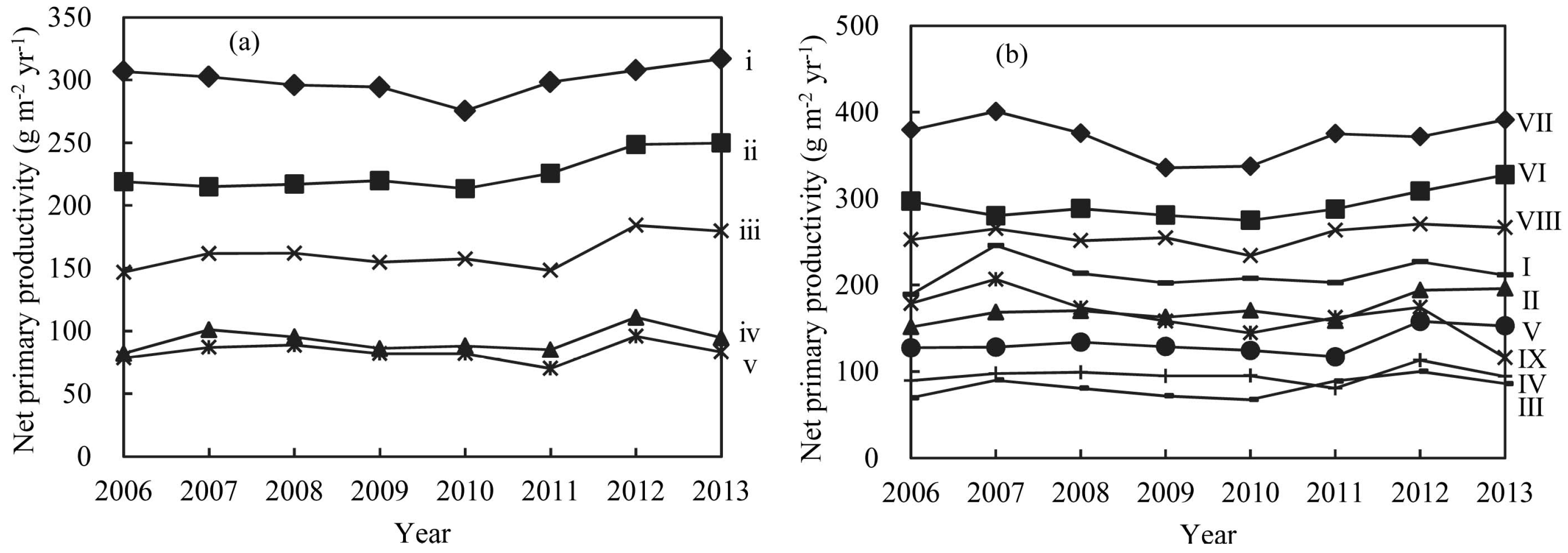
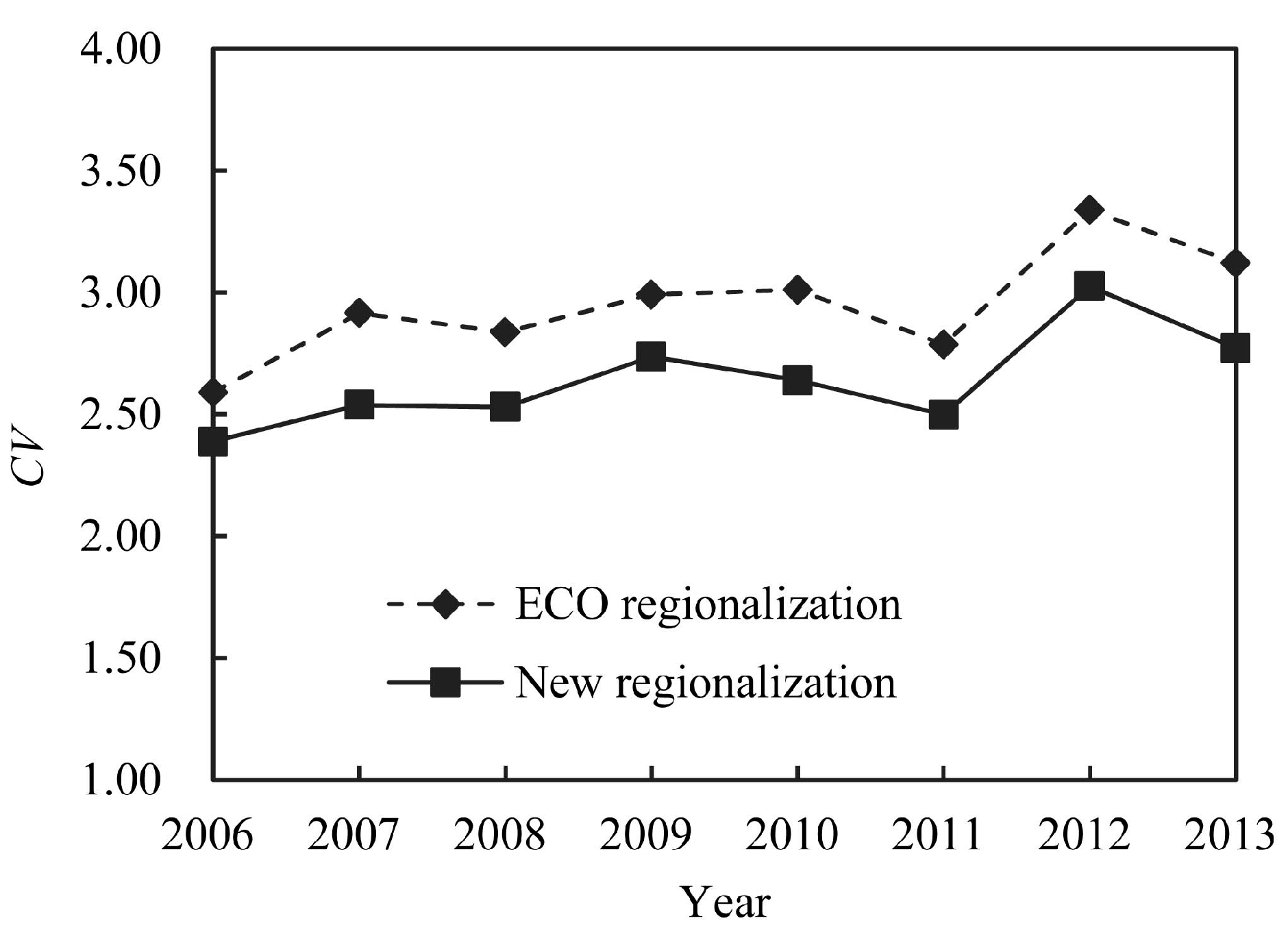
| Vegetation Type | Definition and corresponding vegetation type in the UTM classification system |
| Forested Lands | Areas dominated by trees with >60% canopy cover. Corresponds to evergreen needleleaf forests, evergreen broadleaf forests, deciduous needleleaf forests, deciduous broadleaf forest and mixed forests |
| Woody Grasslands/Bushlands | Areas with herbaceous or woody understories and tree canopy cover <60% and >10% or with closed bush cover. Corresponds to woodlands, wooded grasslands/shrublands, and closed bushlands/shrublands |
| Grasslands | Areas dominated by herbaceous cover and <10% trees or shrubs. Corresponds to grasslands |
| Xerophytic Shrublands/Semi-Shrublands | Areas dominated by xerophytic shrubs/semi-shrubs and canopy cover <40% and >10%. Corresponds to open shrublands |
| Passive Restoration Lands | Without irrigation, these areas never have more than 10% vegetation cover at any time of the year. Corresponds to barren lands. |
© 2017 by the authors. Licensee MDPI, Basel, Switzerland. This article is an open access article distributed under the terms and conditions of the Creative Commons Attribution (CC BY) license (http://creativecommons.org/licenses/by/4.0/).
Share and Cite
Chen, P.; Shang, J.; Qian, B.; Jing, Q.; Liu, J. A New Regionalization Scheme for Effective Ecological Restoration on the Loess Plateau in China. Remote Sens. 2017, 9, 1323. https://doi.org/10.3390/rs9121323
Chen P, Shang J, Qian B, Jing Q, Liu J. A New Regionalization Scheme for Effective Ecological Restoration on the Loess Plateau in China. Remote Sensing. 2017; 9(12):1323. https://doi.org/10.3390/rs9121323
Chicago/Turabian StyleChen, Pengfei, Jiali Shang, Budong Qian, Qi Jing, and Jiangui Liu. 2017. "A New Regionalization Scheme for Effective Ecological Restoration on the Loess Plateau in China" Remote Sensing 9, no. 12: 1323. https://doi.org/10.3390/rs9121323
APA StyleChen, P., Shang, J., Qian, B., Jing, Q., & Liu, J. (2017). A New Regionalization Scheme for Effective Ecological Restoration on the Loess Plateau in China. Remote Sensing, 9(12), 1323. https://doi.org/10.3390/rs9121323







